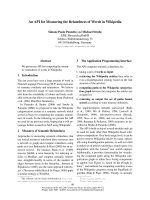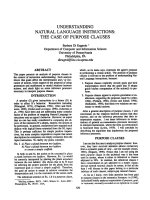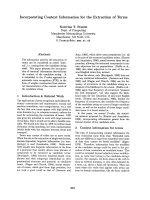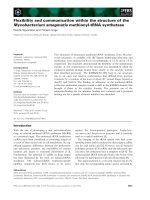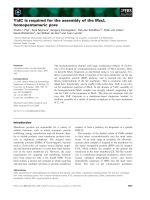báo cáo khoa học: " Achieving a high coverage – the challenge of controlling HIV spread in heroin users" potx
Bạn đang xem bản rút gọn của tài liệu. Xem và tải ngay bản đầy đủ của tài liệu tại đây (196.31 KB, 4 trang )
BioMed Central
Page 1 of 4
(page number not for citation purposes)
Harm Reduction Journal
Open Access
Brief report
Achieving a high coverage – the challenge of controlling HIV spread
in heroin users
Ming-qiang Li
1
, Shui-shan Lee*
2
, Zhi-gao Gan
1
, Yi Tan
2
, Jin-Huai Meng
1
and
Ming-liang He
2
Address:
1
Liuzhou Center for Disease Control and Prevention, Guangxi, China and
2
Stanley Ho Centre for Emerging Infectious Diseases, The
Chinese University of Hong Kong, Hong Kong, China
Email: Ming-qiang Li - ; Shui-shan Lee* - ; Zhi-gao Gan - ;
Yi Tan - ; Jin-Huai Meng - ; Ming-liang He -
* Corresponding author
Abstract
In China, the national plan to open 1000 methadone clinics over a five-year period provides a
unique opportunity to assess the impacts of harm reduction in a country with concentrated HIV
epidemic amongst heroin users. To track the progress of this public health response, data were
collected from the first methadone clinic in Liuzhou, Guangxi, a province with a high HIV
prevalence. In the first 15 months of its operation, a cumulative total of 488 heroin users, 86% of
which male, had joined the programme. The first dose of methadone was given efficiently at a
median of 2 days after registration. Of the 240 heroin users attending the clinic in August 2006,
61% took methadone for four days or more each week. The number of active methadone users,
however, leveled off at around 170 after the first two months, despite the availability of capacity to
deliver more services. The reasons for this observation are: firstly, the provision of one single
service that may not be convenient to all heroin users; and secondly, concerns of heroin users who
may feel insecure to come forward. As broad coverage is essential in ultimately reducing HIV risk,
a low threshold approach is crucial, which should be supported by the removal of social obstacles
and a refinement of the administrative procedures.
Background
The epidemic of heroin addiction has fuelled the global
spread of HIV, a phenomenon that is clearly visible in
many parts of Asia [1]. The growth of this dual epidemic
calls for the development of effective public health
responses, which include the introduction of harm reduc-
tion measures targeting injection drug users and the pro-
vision of antiretroviral therapy to those infected according
to clinical indications [2,3]. The use of opiod agonist sub-
stitution treatment has been proven to reduce injection,
needles-sharing and HIV infection in various studies, and
is now a standard recommendation both for the treatment
of addiction and for HIV prevention and control [3,4].
Internationally, the expanded access of methadone main-
tenance treatment is prioritized, through the scaling up of
harm reduction programmes in many countries. Though
there is no lack of evidence in support of methadone
maintenance [5], debates have continued because of the
relative scarcity of fully evaluated programmes in develop-
ing countries.
Published: 15 February 2007
Harm Reduction Journal 2007, 4:8 doi:10.1186/1477-7517-4-8
Received: 22 December 2006
Accepted: 15 February 2007
This article is available from: />© 2007 Li et al; licensee BioMed Central Ltd.
This is an Open Access article distributed under the terms of the Creative Commons Attribution License ( />),
which permits unrestricted use, distribution, and reproduction in any medium, provided the original work is properly cited.
Harm Reduction Journal 2007, 4:8 />Page 2 of 4
(page number not for citation purposes)
There are lessons to be learned from the recent initiatives
of China where the HIV spread in heroin users has taken
root in some provinces, especially those bordering the
Golden Triangle [1]. Of the estimated 650,000 persons
living with HIV in the country, heroin users who shared
needles accounted for 44.3% of the total [1]. Over the last
year, harm reduction has been introduced as one of the
key national intervention strategy. The national plan was
to set up methadone clinics in 1000 sites over a five-year
period [6]. The future of China's HIV epidemic obviously
depends on how effective the country is in its operation-
alisation of the harm reduction strategy. Guangxi is one of
the hardest hit provinces so far, with the HIV prevalence
in heroin users in rural areas high at 25% [5]. Methadone
treatment has been introduced as a public health pro-
gramme in the province since about two years ago. To
assess the progress of this new targeted population-based
strategy, we reviewed the work of one of the first metha-
done clinics in the country.
Methods
Liuzhou is the second largest city of Guangxi. The reported
number of heroin users in the Liuzhou City is around
7000. The clinic is housed within the Skin and Sexually
Transmitted Disease Clinic of the City's Centre for Disease
Control. While the Clinic is not situated at the heart of the
City, it's within reach (3 Km radius) from where most her-
oin users cumulate. The Clinic is staffed by 5 doctors, 1
counselor, 2 nurses, 2 pharmacists and other supporting
administrative personnel. We reviewed the case records
and workload statistics of the Clinic since the clinic's
opening in May 2005. An unstructured interview of 10
randomly selected clients was conducted by two of the
authors at the clinic. Approval was sought from the local
health department. Ethical approval was obtained from
the Ethics Committee of the Chinese University of Hong
Kong.
Findings
Overall, between 11 and 56 (mean = 35) new drug users
each month registered at the Liuzhou Methadone Clinic
since its opening. As of the end of August 2006, a cumula-
tive total of 488 heroin users, 86% of which male, had
joined the programme. Registration is required for joining
the programme, with the following entry criteria: (a) her-
oin use for over one year; (b) age 20 or above; (c) resident
of the city; and (d) having passed the physical checkup.
Individual application is then submitted for official
endorsement by the authorised office. The first dose of
methadone is given at a median of 2 days after registration
(range: 0 to 9 working days). Of the 240 heroin users
attending the clinic in August 2006, 61% took methadone
at least 4 days each week.
The number of active methadone users has however lev-
eled off at around 170 after the first two months (see fig-
ure 1). Despite a high number of heroin users in the city,
new admission to the programme has not increased.
Clearly the service of a clinic has not saturated, and there
is adequate capacity to take in at least twice the current
number of heroin users. Discussions with registered
methadone users revealed a number of reasons. First of
all, many heroin users may not be living in close proxim-
ity to the methadone clinic, and have therefore chosen not
to travel long distances to access the service. According to
the regulations, methadone must be taken under supervi-
sion on a daily basis at the clinic. Secondly, some heroin
users did not feel comfortable in coming forward for treat-
ment as they ran the risk of being arrested as drug taking
is and has continued to be a criminal offence. It would
take time for a common understanding to be developed
by different government sectors on the role of methadone
clinics at the field level. Thirdly, the strict criteria of admis-
sion also meant that only a fraction of the heroin users on
the street are eligible for enrolment.
Discussion
Against the background of an escalating HIV prevalence in
heroin users around the world, it's reassuring to witness
the establishment of substitution treatment in the world's
most populous country. From a public health angle, there
are lessons from the experiences in Liuzhou. Foremost,
one key indicator in assessing the effectiveness of harm
reduction is its coverage. Broad coverage serves two pur-
poses: general reduction of risk behaviours [7]. and an
alteration to the configuration of social networks of high
risk-taking heroin users [8]. In Liuzhou, there're 1000 her-
oin users who have enrolled in a separate needle exchange
programme. These, together with the current ones on
methadone, account for some 20% of all heroin users in
the city that have access to some forms of harm reduction
service. Because of the low HIV prevalence in neighbour-
ing Hong Kong, we use the latter's experience of having
>60% heroin users in contact with the territory's metha-
done clinic network as a yardstick for assessing coverage
[7]. With the plateau that has not been reached, it would
take a long time before a reasonable coverage can be
achieved in Liuzhou.
To improve coverage, substantial changes in social envi-
ronment are needed, both in removing the obstacles and
in facilitating the enrolment of heroin users. Setting up of
small multiple clinics would be one strategy to promote
coverage. With the functioning of just one clinic, the
unmet needs cannot be managed effectively. The opera-
tion of multiple conveniently located methadone clinics
or even out-reach services are means of solving the prob-
lem. The efforts required to set up multiple clinics in
remote rural areas would likely be phenomenal. The exist-
Harm Reduction Journal 2007, 4:8 />Page 3 of 4
(page number not for citation purposes)
ing programme falls short of a truly low threshold
approach, the latter characterized by a combination of
ease of access and the absence of obligatory requirement
for staying on in the programme [9]. Restrictions imposed
through the entrance criteria and high governmental
expectation would easily discount the proportion of vul-
nerable community that could benefit from substitution
treatment. Finally, it is clear that the establishment of
methadone clinics reflects only the very first step towards
the ultimate target of harm minimization on a population
scale. Through this long process, means to improve cover-
age would be crucial.
Competing interests
The author(s) declare that they have no competing inter-
ests.
Authors' contributions
SL and MH conceptualized the study; YT collected data
and conducted analysis; SL and TY conducted the inter-
views; ML, ZG and JM participated in data analysis and
contributed to study design; SL prepared the manuscript
and incorporated opinions from all others.
Acknowledgements
The authors thank all staff and clients of Liuzhou CDC and methadone clin-
ics for their assistance in making this study possible.
References
1. MAP (Monitoring the AIDS Pandemic): Drug injection and HIV/
AIDS in Asia. Washington: MAP secretariat; 2005.
2. Long EF, Brandeau ML, Galvin CM, Vinichenko T, Tole SP, Schwartz
A, Sanders GD, Owens DK: Effectiveness and cost-effectiveness
of strategies to expand antiretroviral therapy in St. Peters-
burg, Russia. AIDS 2006, 20(17):2207-15.
3. Sullivan LE, Metzger DS, Fudala PJ, Fiellin DA: Decreasing interna-
tional HIV transmission: the role of expanding access to opi-
oid agonist therapies for injection drug users. Addiction 2005,
100:150-8.
4. Institute of Medicine: Preventing HIV Infection among Injecting
Drug Users in High Risk Countries: An Assessment of the
Evidence. Washington DC: National Academies Press; 2006.
5. Liu W, Chen J, Rodolph M, Beauchamp G, Mâsse B, Wang S, Li R,
Ruan Y, Zhou F, Leung M-K, Lai S, Shao Y, Jackson JB: HIV preva-
lence among injection drug users in rural Guangxi China.
Addiction 2006, 101:1493-1498.
6. Qian HZ, Schumacher JE, Chen HT, Ruan YH: Injection drug use
and HIV/AIDS in China: review of current situation, preven-
tion and policy implication. Harm Reduct J 2006, 3:4.
7. Chan MKT, Lee SS: Can the low HIV prevalence in Hong Kong
be maintained. AIDS Educ Prev 2004, 16(suppl A):18-26.
8. Rothenberg RB, Potterat JJ, Woodhouse DE, Muth SQ, Darrow WW,
Klovdahl AS: Social network dynamics and HIV transmission.
AIDS 1998, 12:1529-1536.
Registration of drugs users at a methadone clinic in Liuzhou, GuangxiFigure 1
Registration of drugs users at a methadone clinic in Liuzhou, Guangxi.
0
50
100
150
200
250
ju
n
Y
ea
r
1
aug
sep
oct
nov
dec
Year 2
fe
b
ma
r
apr
ma
y
ju
n
j
ul
aug
new clients
defaulters
active clients
Publish with Bio Med Central and every
scientist can read your work free of charge
"BioMed Central will be the most significant development for
disseminating the results of biomedical research in our lifetime."
Sir Paul Nurse, Cancer Research UK
Your research papers will be:
available free of charge to the entire biomedical community
peer reviewed and published immediately upon acceptance
cited in PubMed and archived on PubMed Central
yours — you keep the copyright
Submit your manuscript here:
/>BioMedcentral
Harm Reduction Journal 2007, 4:8 />Page 4 of 4
(page number not for citation purposes)
9. Millson P, Challacombe L, Villeneuve PJ, Strike CJ, Fischer B, Myers T,
Shore R, Hopkins S: Determinants of Health-Related Quality of
Life of Opiate Users at Entry to Low-Threshold Methadone
Programs. Eur Addict Res 2006, 12:74-82.




